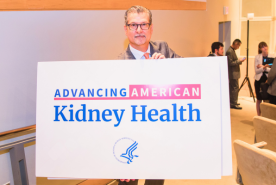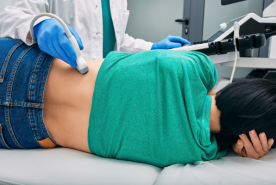July 06, 2023
CKD-aP, CKD-associated pruritus, or uremic pruritus are all names for a common and disruptive symptom of kidney disease: itching. According to one survey, pruritus is common in non-dialysis stage 2 kidney disease patients with up to 58% reporting at least somewhat intense, recurrent itching.1 In a separate survey of patients on dialysis, 61% self-reported a somewhat intense itch and 25% reported very or extremely intense itching.1
Dawn Edwards, a dialysis patient with CKD-aP, and Dr. Tariq Shafi, Director of the Nephrology Department at the University of Mississippi Medical Center, sat down to discuss this troubling symptom and answer some frequently asked questions.
What does CKD-aP feel like?
[VIDEO::http://www.youtube.com/watch?v=nsWmEuW_NWI::aVideoStyle]
"CKD-associated pruritus is different from the common itching that most of us have experienced, like a mosquito bite," said Dr. Shafi. "This is a form of chronic itching that tends to be more persistent, starting at various times without a clear reason as to what brings it on."
Sadly, many people with CKD-aP suffer silently because they don't know about its connection to kidney disease, prioritize other health issues, or don't want to go through lengthy and inconvenient doctor consultations.
"It all started 32 years ago when I was 23 and formally diagnosed with end stage kidney disease requiring dialysis. Right before I started dialysis, I noticed I was having more itching than normal. I thought I could take care of it myself by showering more often and applying different types of lotions and creams," Dawn said. "The itching felt like it was coming from the inside and seemed to become more persistent at night."
CKD-ap can be caused by a variety of reasons, including:
- Increased toxins in the body and too few dialysis sessions
- Limiting fluids for hemodialysis or the removal of excess fluids during treatment
- An immune response
- Shrinking sweat glands
- High levels of the parathyroid hormone (PTH)
When Dawn couldn’t fix the itching on her own, she sought the help of her care team.
"I spoke to my medical team about it, but I felt patient-shamed since it is associated with high phosphorus levels," Dawn said. "Even though my phosphorus was within the normal target range, I was still told that it was out of control and to stop eating certain foods. I didn't stop asking questions until we found a solution. This is why self-advocacy is so important. If there comes a point when you know something is going on that you can't explain or it's interfering with your quality of life, speak to your care team."
Learn more about the causes of CKD-aP and download our factsheet to dig into the facts further.
Alleviating kidney disease-associated itching
So, what helped Dawn?
“I tried everything from cold showers instead of hot and different lotions but to no avail," said Dawn. "What helped me was doing home hemodialysis. More dialysis treatments made the itching better."
Sign this petition to help expand access to home hemodialysis for all people with kidney disease.
Pruritus treatments include:
- Pills for nerve problems
- Antihistamines
- Omega-6 or omega-3 fatty acids to bind toxins in the gut
- Difelikefalin for hemodialysis patients
- Light therapy to reduce inflammation
- More dialysis treatments or switching to a new mode of dialysis
It's also important to follow a basic skin hygiene routine.
"Make sure the skin is not dry. As we grow older, skin tends to get drier so use a high-quality moisturizer to keep it moist, especially in areas that are affected by itching," Dr. Shafi said. "Take cooler showers and gently pat yourself dry instead of rubbing vigorously. With aging, the fat layer under the skin starts to get thin. If you take a shower with hot water or you rub yourself dry really hard, it can cause skin to further break down. While there is no magic bullet to fix pruritus, there is hope. With appropriate treatment, many people find relief."
Everyone is different, so speak with your healthcare team to find a solution that works for you.
Learn more about CKD-aP treatments.
Common questions about itching
During Dawn and Dr. Shafi's discussion, they answered a few common questions about CKD-aP. Here are the top three.
Question 1: Should you see a dermatologist or a skin specialist for CKD-aP?
"Patients with itching need a full evaluation to determine what is going on. I may refer patients to a dermatologist if they have unexplained skin ulcerations (an open sore), a bump, or have another internal disease that could cause itching. There are also types of CKD-aP that may benefit from light therapy at a dermatologist’s office," Dr. Shafi said. "If I or the patient don't have the answer, I always suggest they seek more help to get to the bottom of it."
Question 2: During which stage of CKD is itching most common?
"It is very common for people with advanced kidney disease requiring dialysis to have this severe form of itching,” said Dr. Shafi. “People in earlier stages may also experience it but it isn’t as common."
For Dawn, the itching began before dialysis, but she ignored it since she didn't know she had kidney disease yet. Once she started hemodialysis, the itching increased–This could have been caused by increased toxins in her blood and insufficient dialysis treatments, limiting fluid intake for safer hemodialysis treatments, or dialysis treatments removing fluids from the body.
"Once I started in-center dialysis treatments three times a week, I really noticed the itching. I did speak up and complained about it. The dialysis staff was giving out antihistamines during the dialysis session but later stopped. It was up to me to bring my own or ask for it," Dawn said. "Once I asked to switch to home dialysis and increased my treatments from three times a week to daily, it got better.”
Need support? Get matched with a Peer Mentor who has lived with pruritus. You can also connect with others in our Kidney Communities or on Facebook.
Question 3: When is CKD-aP most likely to occur?
"There used to be certain dialysis membranes that could cause an allergic reaction in people. That has changed now that membranes have improved. So, most of the time it's not related to the treatment itself," Dr. Shafi said. "It can happen at any time, whether you're in the chair or not, but it can be useful to keep an eye on timing. For example, if itching happens in between dialysis sessions, your blood might not be cleaned enough. If it happens during the night, maybe the detergent on the bed sheets is affecting you."
Have questions? Contact NKF Cares, our patient helpline, and read more CKD-aP patient stories.
Sources
1 National Kidney Foundation. Chronic Kidney Disease-associated Pruritus (CKD-aP) Fact Sheet. National Kidney Foundation. https://www.kidney.org/sites/default/files/pruritus_factsheet_v3.pdf. Accessed July 3, 2023.









